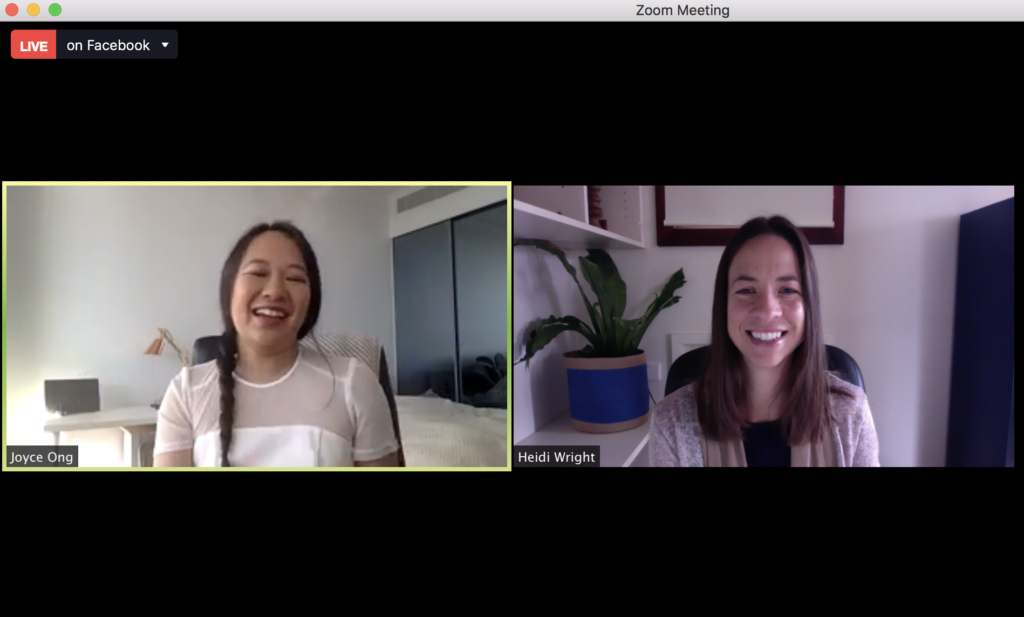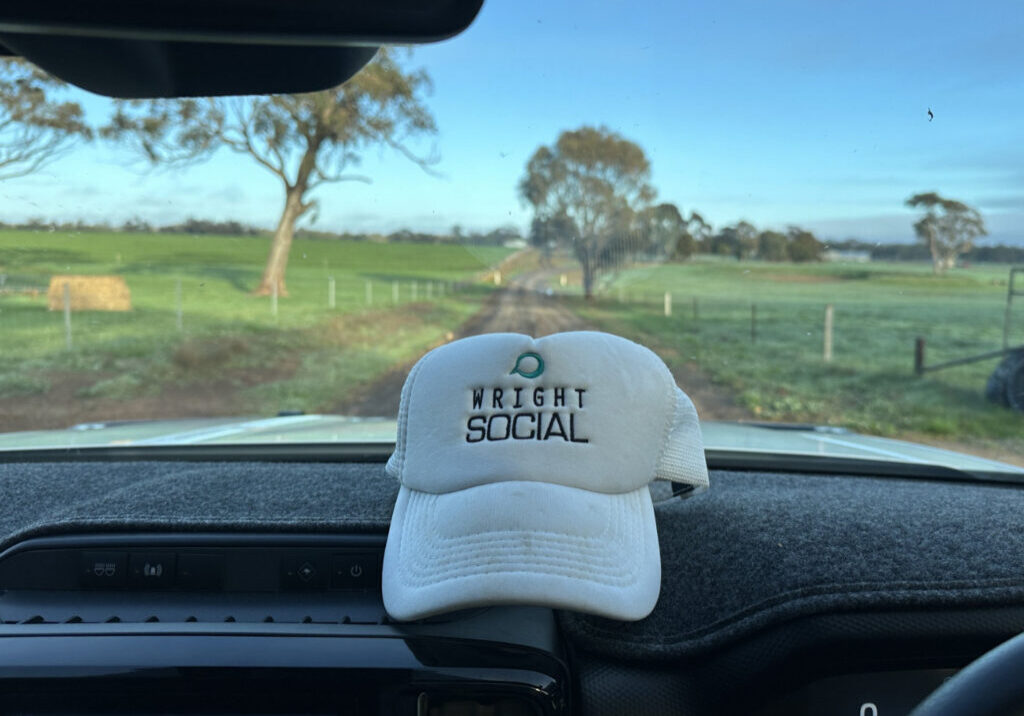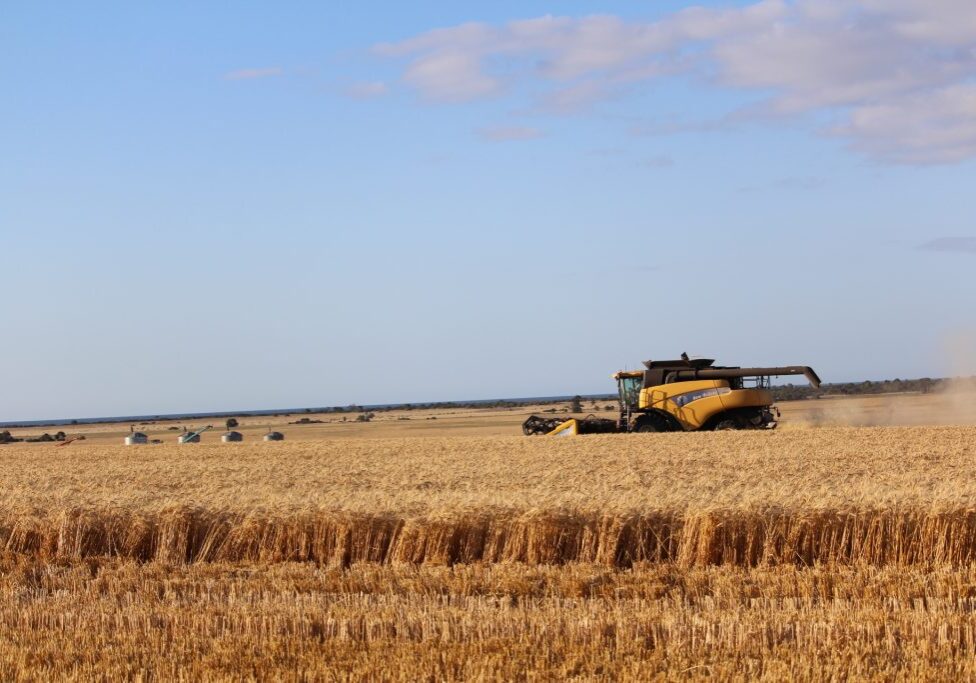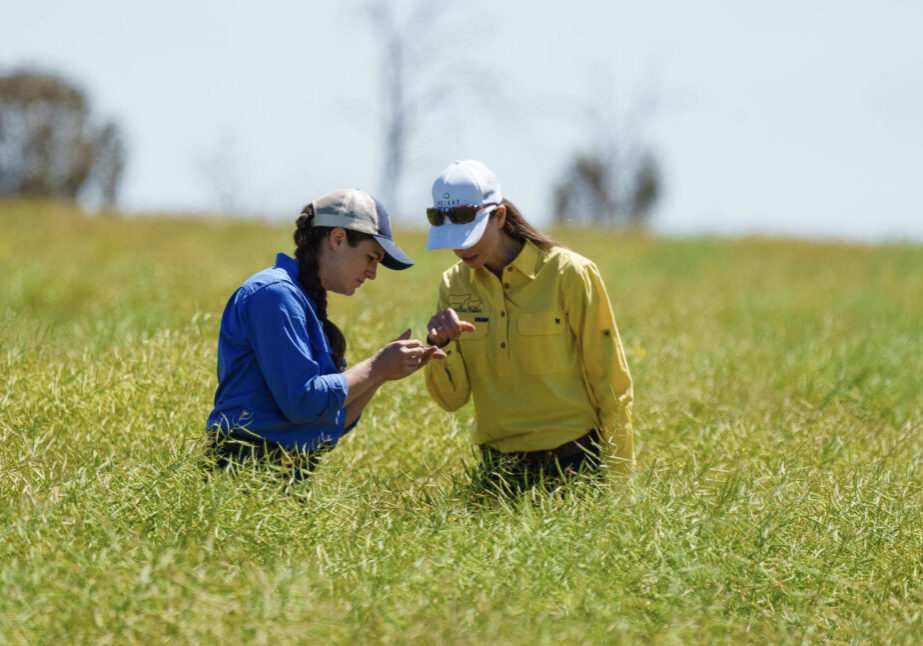Out in the paddock, with the cattle or client and need a 101 on making quality videos on your phone?
Joyce Ong is photographer and videographer. With a wealth of experience, she’s got you covered.
Heidi Wright, Director of Wright Social, speaks with Joyce Ong, getting her expert advice on filming and editing, plus technology recommendations.

Heidi Wright: Let’s kick into gear. Thank you so much. I know your time is precious, Joyce, so thank you for joining us.
Now you are an international videographer and photographer and over the last 10 years you’ve worked with people like Richard Branson in the photography space, Shakira, and you’ve also worked with the likes of Johnson & Johnson, Aus Harvest, Sony. They’re some big brand names. What was that like working with the bigger brands in the space that you’re in?
Joyce Ong: It’s great. It’s fun. It’s actually not too different to working with small brands, but I guess it comes with the name. But you know, events are events, and going on with the camera or doing videos and stuff it’s fun no matter if it’s big or small.
Heidi Wright: Yeah, that’s awesome to hear. Well look, we’re really keen to understand the 101 of creating videos on your phone when we’re on the go, because when we’re in the ag business we’re often outside, we’re very busy people. We’ve got an opportunity, a very short opportunity, to take a bit of footage on our phone but quite often the footage stays on our phone because we just don’t know what to do with it.
I’ve obviously been in the content creation space. I understand that it takes planning and process to get a story and then to have that story come out in a way that you can then have a meaningful conversation with your ideal customer through the video. But I think one challenge that we all have is we know it’s easy to take that footage, but it’s not so easy to actually use that in our marketing and have it come across in a way that we’re actually proud about and that represents our brand, so could you give us the 101 on using your iPhone to create videos that are pro?
Joyce Ong: Yeah, did you want to talk a little bit about the planning and the marketing side first? Or did you want to go into equipment?
Heidi Wright: Well, let’s talk about the planning and the marketing and then that’ll lead us into the equipment space. So, how do you plan for your on-the-go iPhone videos or smartphone videos?
Joyce Ong: Yeah, well sometimes they are planned and sometimes they’re not. Sometimes you might just be outside, and you’ll be like “oh my gosh, good moment to capture this right now”, and then you figure out what to do with later.
But for the times that you do plan, it depends, sometimes I just do a brain dump, so, what have I got on today? What can I use in my schedule today to get a quick video snippet? Some people do a morning walk on the beach and during that time they do a talk while they’re walking on the beach, you know, and so people just go through their normal lives and then when they find the opportunities grab their phone out and start a recording, so that’s one way to do it.
And another way to do it is you realise “oh I’ve got a free two hours today. Maybe I’m going to do my content and then I’m going to have 10 content pieces ready by next week”. So, you can block out a bunch of time and then do a little brain dump, go “okay cool, what are the most frequently asked questions that I get asked all the time from my clients and in my emails?” Okay let’s just jot those down and then each one of those frequently asked questions are going to become a video, so that’s another way to do it and that’s a quick way to get 10 easy content pieces out.
Heidi Wright: Yeah, and I feel like that’s much more effective for ag businesses or small businesses that actually know the value of social media in generating results for their company or business, but it does take planning, as you say, and knowing who your target market is is step one. And certainly, step two is crafting that message so you know what message you want to carry through, and step three it’s like “okay, now how can I use my phone to capture that content?”
So, now we’ve covered that element of content marketing, again we could talk for hours just on that alone, but I really want to get into the tech side, because I know there’s a lot of people that wonder “okay, is our iPhone enough? Are the capabilities of the iPhone enough when it comes to audio, lighting?” And if we feel like we want to create more professional video, what are some sorts of equipment that we need to be thinking about in order to really have that polished feel?
Joyce Ong: Yeah, so the iPhone is pretty good by itself. You can use it just like it is with no microphones, and if you’re outside it’s normally fine with the picture quality because it’s nice and bright. Where you might run into a bit of trouble with the lighting is if it’s getting dark because the phones at the moment don’t handle low light well, so as soon as the sun starts going down you’ll start losing quality.
And also with the sound, if it’s noisy around you, it’ll be hard to pick up yourself. So right now, I’m inside. I could just film on my phone right now with no microphone and it would be fine, but if you’re outside you’re dealing with noise, wind, a whole bunch of stuff.
So, I actually bring this little guy with me, and this is called “Videomic Me” by the brand called RØDE, and it’s plug and play. Plug it into the phone, normally I have to take my cover off, and then that just increases the quality of the sound. So, I just point it at me. So, the thing about this microphone is it’s directional, so whatever it points at that’s what it’s going to pick up. So, if you’re going “okay cool, Heidi, tell me something”, and then Heidi talks and then “Joyce, tell me something”. So, you have to point it at whoever is talking, but if it’s just you talking, just make sure it’s pointed at you, and it’s literally plug and play. It’s really easy.
Heidi Wright: Do you have an adaptor that works with your phone or that particular RØDE mic?
Joyce Ong: It’s built for the phone, so you literally just plug it in. I’ve got an iPhone, so this is like the iPhone plug there, but for the Android users there’s another version which has the Android plug as well.
Heidi Wright: Cool, I actually didn’t know that it could go straight into your phone, because I have the mini RØDE mic as well, but I have to use it on my iographer, which is like a little stand like this, and I actually put my phone in the middle, so that’s brilliant to be able to have it connect straight in.
How much are we looking at for something like that? Just as a quick snapshot do you know how much they retail for?
Joyce Ong: Yeah, I think I bought mine for about $125 online. Everything for at home is quite cheap.
Heidi Wright: When we’re outside filming, wind is a massive issue, so when we’ve got our iPhone and we have something like the RØDE mic, what else do we need to ensure that we’re not going to have an audio blast?
Joyce Ong: When you actually buy this, it comes in a box and in that box is like this big fluffy thing, it’s called a windsock. I don’t have one with me at the moment, but you just stick it on top and then that kind of protects the microphone from the wind noise.
Heidi Wright: Cool, great.
Joyce Ong: The other thing that you could do is you could get one of these little ones instead. They’re a bit cheaper, they’re like $100, and you could also put that onto your shirt, so the sound is closer to you. I don’t use this one that much because, I guess I’m lazy, and it’s easier for me to just plug this in than put this into here and then put it under my shirt and make sure I’m wearing it nicely, and yeah it’s just a couple of extra steps, but there’s this one as well which can protect from the wind, depending on if you like put it under your shirt and cover it a little bit, so that’s another option too.
Heidi Wright: Brilliant. Well, we’re all about on the go using our iPhone so I think the non-cable is definitely the way to go there, yes.
Let’s talk about lighting. So, if we are inside and we want to use our iPhone and that mic, for example, or a directional mic, to take a selfie video, what do we need to consider when it comes to lighting? And what’s your top choice in terms of having something that’s versatile enough to be able to just put anywhere no matter where you are? In your office if we don’t have a lot of natural light? What’s your recommendation there?
Joyce Ong: Yeah, so I’ve got these little LED panels, and I’ve got one right here. That’s without light at the moment. It’s still quite nice, because I’ve got a window right there. So, if you don’t have any lights at all, just see if you can face a window, and that should be pretty good. But then this is just a little LED panel, which sits right on top of here, and you can change the colour from a yellow light to like a white light as well. And you can also change the strength, so you can dim it and then brighten it up as well. So yeah, these LED lights are one of the ones that are really good. They’re really portable. They’re light. They come with batteries, and you can even buy like super cheap versions from Bunnings.
Heidi Wright: Yeah, perfect. In terms of white light versus more of a warm light, in what situations do those two come into play?
Joyce Ong: I would say match whatever your actual natural lighting is. So, if you’re out in the daytime it’s normally a nice white light. But hang on, if you are outside, you probably have the sun, so you probably don’t need extra lighting. But if you’re inside by a campfire, that’s more of a yellowy light. Lamps as well sometimes have a more yellow tinge as well. So, just have a look at what other lights you have and match that colour, because white is fine, yellow is fine, depends on your situation. For example, we film a lot of dentists, and we always use white lights for dentists.
And then for like family stuff, nice family photos, family videos, we go with a more yellow light because it’s more warm and more friendly, and it’s more of like a lovey dovey vibe as well.
Heidi Wright: Yes. Awesome. So, we’ve covered audio on the go. We’ve covered lighting on the go. Let’s talk about stability, because some of us have the shakes, and I know myself, like if I’m holding my phone up for long periods of time, I will definitely start to do this.
So, what’s your best advice for a selfie tripod when we want to start to talk to the camera? And what is the best tripod for when you’ve actually got someone else holding the camera or you want to be independent of your phone camera, whereby maybe you have it set up in the paddock standalone, where you don’t have a Toyota bonnet to rest on or you don’t have a fence post to be able to rest it? What’s your top two recommendations in those two scenarios?
Joyce Ong: Yeah, I think with tripods, any tripod is fine, but when you’re doing it with a phone, you’ll need to have the phone clamped. So, you can buy the phone clamps by themselves, but I just got mine as a part of a tripod from Officeworks, actually. So, any little tripod or you can get a normal big camera tripod, and then just attach the top of it to the actual camera tripod to give you the height you want if you want to put it higher than a little tiny tripod.
Heidi Wright: When it comes to selfie videos and being able to flip the camera, I can’t actually do that on my iPhone. So, for example, I think what a really cool feature to have on your phone would be to be able to film yourself like this, and then click the flip and it flips around to the scene so you can actually talk about what you’re seeing in the field or the paddock, and then you’re flipping it to the actual scene or view. Have you got any hacks around that? Aside from I guess, just editing?
Joyce Ong: Yeah, so you can’t really do it mid-video, as you said before, but what I would do, and what we normally do is we record all the talking part first. So, like, “talk, talk, talk talk, talk, talk, paddock, talk about paddock”. Then after that, I’ll stop the video.
So, this is a gimbal. This makes the shots really stable. So, it’s another kind of tripod, but you can walk with it and it’ll be really stable. So, I’ll put the phone in the gimbal, or if I don’t have one, I’ll just hold it, and then I’ll take all the paddock shots. You still have to edit it, though. So, it’s not really a hack for the editing, but you combine the talking with the shots of the paddock later, and then your voice will then become a voiceover when the paddock shots are being shown, but it is within editing.
Heidi Wright: Yeah, no, that’s cool. And you know, I think that in itself, just being organised with your shoot to begin with, will help you when it comes to editing because you’ll have all of your imagery in line and organised in the way that you filmed out on your iPhone. So, it’s not going to become so overwhelming when you go to edit.
Let’s talk about a little bit about if you like to set up, or do you feel like we’ve already covered that in terms of where to shoot what to look for?
Joyce Ong: Yes, I think we’ve covered most of it. I just want to mention something with what you said before. You could also do it the other way, like if you see something in the paddock and go like “oh, I got to go film that”, just quickly go and film that, and then after that you can do the selfie video and then talk about what you saw. So, you can do it that way as well.
Heidi Wright: Yeah, cool. I’ve just got Diane, she’s asked “is that a magnetic tripod?” The one that you had. Is that magnetic? Does that connect to anything magnetic?
Joyce Ong: I have another version of this that is magnetic. This one isn’t. I bought this one because it had little arms as well, so I can put a little light there and a microphone as well if I wanted to. But the one that’s magnetic only has the three legs and the bottom of the three legs are magnetic there.
Heidi Wright: Yeah, awesome. Okay, and Jo has asked, I think this was more related to the mini RØDE mic, and I think there’s always compromises when it comes to equipment, because when you’re using your iPhone it is about having comfort and being versatile, as opposed to the big sort of equipment that will do a quality job, but it’s going to be clunky to carry around, but Jo Edie has asked “is this useful for interviews? How do you get the interviewer and the interviewee voice at the same sound level?”
So obviously, when you’ve got the RØDE directional mic and you’re filming one, and then you’re putting it across to the other?
Joyce Ong: So, with an interview, I would actually use two of these, just so I don’t have to like point from one person to the other person, because that’s the only way you get clear sound. There’s been a shoot where they didn’t tell us that they were going to bring an interviewer in, and they randomly just had an extra person, and so we’re like, “okay”, but we put it in between them. The sound was still fine, but it wasn’t as clear as when it was pointing directly at somebody. So, what we normally do is we just get two of these ones, and there’s like a double adapter for the phone. So, you can plug two of these and headphones in as well.
Heidi Wright: Alright, let’s jump into editing now, because this is often the big challenge, where you’ve got this great footage and you want to edit it. Now some editing, you just want to get done, and when you’re just creating a 15 second vertical video to go on your story on Instagram, you want to do it in five minutes. What’s your go to editing app for those sorts of videos?
Joyce Ong: On the phone, there’s a really good and easy to use one called Spark. If you have an iPhone, iMovie I’m pretty sure is free. So, you can just try that, and iMovie also has create your own project or trailer. It’s got like premade templates, I guess. So, it makes it look like a mini movie trailer. So that’s another option too, just for some fun.
Heidi Wright: Yeah, awesome. I find videoleap really good, except the page, it’s not free. You need to have a paid version but that allows you to add some pretty cool effects.
Joyce Ong: Yes, the videoleap and there’s another one called Filmora. So, depending on your skill level and how much you want to get into it, the easiest one would probably be Spark, then iMovie, then videoleap, and then Filmora.
Heidi Wright: Yeah, cool. In scenarios, we’re often wanting to empower our customer to do their own videos to send to us in order to share. If you were talking to me as a customer now, and you were asking me for a testimonial video, how would you instruct me to use my iPhone to deliver that to you, knowing that I don’t have a mini RØDE mic, I don’t potentially have an LED light, what would your advice be if I wanted a nice in paddock shot?
Joyce Ong: Yeah, good question. So, I would give you a screenshot of this and say, “please film yourself like this so you can see upper body, and please face some light so you can see your face and your eyes clearly”. And then I would say important thing is “please answer the questions in full. So, you put the questions into your answer”. So, “what’s your name, Heidi?”
Heidi Wright: My name is Heidi Wright.
Joyce Ong: Yes, does that make sense? So that you have context as well. So, if you’re doing an interview, do it that way, otherwise, if they’re just reading a list of questions, for example, “how was my business going before meeting Heidi?” “Before meeting Heidi, my business was XYZ”.
Heidi Wright: Yeah, fantastic. Okay, great. So, let’s talk now about when we look at engagement with our videos. So, we’ve got our video, we’ve edited it in an app, and say we’re now ready to upload it to a social media network. When it comes to captioning, subtitles, headings, what must we do? What must businesses hear from you about adding that extra punch or information around your visual in order to get a better response?
Joyce Ong: Yeah, so firstly, it’s probably getting from the easy do it yourself to hire somebody else to do it now, because to do it, to put subtitles on videos for your phone, and just doing it on your phone, it’s quite annoying to do.
Heidi Wright: I agree. Those subtitles can take quite a lot of time, particularly, sorry to interrupt, but particularly when you’ve shot something on your iPhone, and you’ve taken the time to do it portrait, and then you want to put it up on IGTV and you want subtitles in there. YouTube will automatically put subtitles on, but you can’t export a YouTube video with those subtitles and then get it onto Instagram TV. So, then it comes down to a manual placement of the subtitles in order to get that happening, which we know is critical now for social media because a lot of people will play videos on mute. So, it’s nearly like we need subtitles, but it doesn’t look like there’s really a straightforward answer for subtitles.
Joyce Ong: No, there’s not. I’ve been exploring different apps as well that do automatic captioning as you record the videos, and even those I wouldn’t actually use apart from testing it. Like when I was testing it, it was great, but I had to speak really slowly and very clearly so that the subtitles could pick it up as I was talking, and I’m like “this is not going to happen”. I did try and look for apps that did automatic subtitles, but still, I’m always going to get an editor to do it, because it’s not worth the time or effort. Unless you love doing that thing, or love doing editing and it is your thing, I would get somebody to do subtitles.
So, for social media, think about where people are viewing your videos. Most people are actually going to view it on their phones, so you want to maximise the real estate space. So, most people look at their phones this way. And most people are actually too lazy to just turn their phone this way. So, you want to make vertical videos for Instagram TV, for scrolling on Facebook, to maximise real estate. So, even if you have filmed your video this way, you could actually get an editor to add a heading up here, and then add subtitles down here, then all of a sudden, your video is still the same size, but you’ve added that to make it square or vertical.
Heidi Wright: Yes, and that makes total sense. Let’s talk teleprompters. So, often we as marketers will write a blog and we want to, you know, cross purpose that content into video, and then we might want to have a podcast from that etc. So, what’s your go to teleprompter when it comes to talking to the camera or talking to your iPhone?
Joyce Ong: There’s a really great teleprompter app on the phone called teleprompter. So, easy to remember, let me show you the logo. It is just a little video camera. There’s one with a white background and one with a black background. I think one is just the paid version, and one is the free version.
With the free version, you could only practice, but I don’t think it’ll let you save the video with the subtitles. So, then it’s about $27, but it was $27 very well spent, because I use it all the time. So, you just copy and paste in the script, then it rolls and you can change the size, and you can change the speed as well. So, it’s just a matter of getting used to kind of reading, but not sounding like you’re reading, and also getting the distance right, because if you’re up really close, you can tell if you’re reading, but if you’re a little bit further away, it’s less noticeable. So, it’s about getting the distance and getting the speed right and getting the flow to make it sound more natural.
Heidi Wright: So, we can all be news readers is what you’re saying with a little help?
Joyce Ong: And practice.
Heidi Wright: I think that’s really helpful for being able to give people dot points. Often, you know, I work with businesses that have sales teams, and content is important for their sales teams, but they need some prompts. So being able to provide those points and have those guiding scripts, give them a few pointers, and then they’re off and away, as opposed to you know, having to think and have that pressure of “oh, I’ve got to remember this all and appear natural”.
I think everything takes practice, and that’s something that we can’t forget. For people completely new to video, even the thought of sometimes putting yourself on video can be enough to have you not do it, but it’s so important, isn’t it?
What advice do you give to people when you’re interviewing someone, and you can see that they’re just like “get me away from this camera”, or they’re totally unconfident and they’re just not feeling up to it that day? What are some ways that you can help make that person feel comfortable?
Joyce Ong: So, there’s different strategies. So, one strategy is to get a friend involved. So, if some people are just nervous by themselves, and they’re trying to film by themselves, you can get a friend either on camera, so if they’re on camera, you can get them to bounce questions off you. So, just have a normal conversation, set the camera up, but then talk to the person, and while it still might take five or 10 minutes to get it going, you’ll eventually be talking to the person normally, and then you can take that video and then cut that up into snippets. So, that’s a way to get natural content.
If the other person doesn’t want to be on camera, or if you want to be the face itself, you can get to get the person to hold the phone for you. You can get the person to just stand behind the camera and smile and nod. I remember when my when my ex-partner was doing his very first TV series, he would go “can you just smile and nod at me from behind the camera all the time?”, and I’m like “sure, I can do that”. Because it’s encouraging to see another person there, even if they can’t actually talk, because if they talk over you, they’ll ruin the sound.
Heidi Wright: Yeah, they’re really good tips. Thank you for sharing those, because you’ve got a wealth of experience, and you’ve dealt with so many different characters with what you’ve been doing in the last 10 or so years that, you know, those tips are really valued, and I know come from experience. So, thank you.
Why don’t you tell us, if someone wants to learn more about some of the insights that you shared here today, where can people go and find you?
Joyce Ong: Cool, I’ve got a couple of websites. So, before COVID we were doing video production done for you. So if that’s your jam, you can go to newheightsmedia.com.au, and then when COVID hit, I decided to teach people how to do it, so I built justshotonmyphone.com, and that one’s a free video series. It goes into four parts. The first one is equipment, and we talk about the equipment that I showed you, just in a bit more detail, and then it goes through setup and then shooting tips and then how to upload and get the files off your phone onto the cloud for an editor. So, that’s totally free and it’s delivered via Facebook, and I know that you guys are on Facebook, obviously, so you can either just type in justshotonmyphone.com or you can type the group in Facebook and search it that way as well.
Heidi Wright: Yeah. Excellent. Well, this has been really great. Thank you so much for joining us, and good luck for the rest of your day. It sounds like you’ve got a busy one ahead.
Joyce Ong: It’s all good. Thank you for having me.
Got questions? Join our FREE Facebook Group for ag-related businesses & professionals to learn and share social media marketing tactics here!
Below are Joyce’s equipment recommendations:
Audio:
The mic referenced in the video was the Røde Video Mic Me – it works with Android and Apple. Sound is clear from the direction it point towards, rejecting noise from behind and at the side ($79).
Lighting:
LED Lamp (a good one for the phone is the pictar smart light ($89), compact LED for smart phones, high quality light in combination with the diffuser and gel filter that improves the quality and character of videos.(Note, a selfie ring USB rechargeable lights with dimmers can be purchased for less than $20).
Tripods:
A good selfie stick with Bluetooth remote that suits both Android and Apple is the Cygnett GoStick ($69)A good stand alone tripod that clamps a mobile with adjustable height is the Black Eye Lens Filming Handle & Tripod ($99).





Leave a Reply